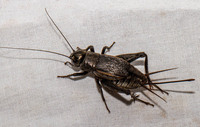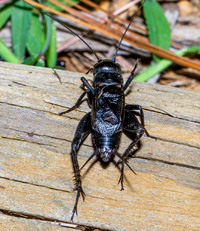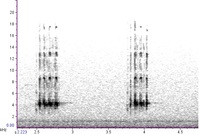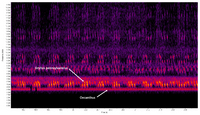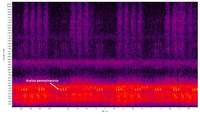Family (Alpha): ACRIDIDAE GRYLLACRIDIDAE GRYLLIDAE GRYLLOTALPIDAE RHAPHIDOPHORIDAE ROMALEIDAE TETRIGIDAE TETTIGONIIDAE TRIDACTYLIDAE
View Gryllidae Members:
Acheta domesticus Anurogryllus arboreus Gryllus unidentified species Gryllus firmus Gryllus fultoni Gryllus pennsylvanicus Gryllus pennsylvanicus/veletis Gryllus pennsylvanicus-veletis Gryllus rubens Gryllus veletis Miogryllus verticalis Velarifictorus micado Hapithus agitator Orocharis unidentified species Orocharis luteolira Orocharis saltator Cycloptilum unidentified species Cycloptilum bidens Cycloptilum pigrum Cycloptilum slossoni Cycloptilum tardum Cycloptilum trigonipalpum Cycloptilum velox Myrmecophilus pergandei Allonemobius allardi Allonemobius fultoni Allonemobius griseus griseus Allonemobius griseus funeralis Allonemobius maculatus Allonemobius socius Allonemobius sparsalsus Allonemobius tinnulus Allonemobius walkeri Allonemobius unidentified species Eunemobius carolinus Eunemobius confusus Eunemobius melodius Eunemobius unidentified species Neonemobius cubensis Neonemobius palustris Neonemobius variegatus Pictonemobius ambitiosus complex Pictonemobius ambitiosus Pictonemobius hubbelli Oecanthus unidentified species Oecanthus celerinictus Oecanthus exclamationis Oecanthus fultoni Oecanthus latipennis Oecanthus nigricornis Oecanthus niveus Oecanthus pini Oecanthus quadripunctatus Neoxabea bipunctata Phyllopalpus pulchellus Anaxipha delicatula Anaxipha exigua Anaxipha litarena Anaxipha rosamacula Anaxipha thomasi Anaxipha tinnula Anaxipha tinnulacita Anaxipha tinnulenta Anaxipha vernalis Anaxipha unidentified species Cyrtoxipha columbiana Falcicula hebardi Gryllidae unidentified species NC Records
Gryllus pennsylvanicus Burmeister, 1838 - Fall Field Cricket
Taxonomy
Family: Gryllidae
Subfamily: GryllinaeTribe: GrylliniSynonym: Acheta pennsylvanicus, Gryllus assimilus pennsylvanicus Comments: One of eighteen species in this genus that occur in North America north of Mexico (Weissman and Gray, 2019), five of which have been recorded in North Carolina.Species Status: Restored to full species status by Alexander (1957), who separated it from firmus, veletis and rubens, all of which had previously been lumped with pennsylvanicus under the name assimilus; Gryllus fultoni was also split off as a new species. Alexander and Bigelow (1960) subsequently described veletis as a new species, based on its different phenology but only minor differences in morphology. A molecular phylogenetic study by Huang et al. (2000) supports these divisions and links pennsylvanicus most closely to firmus among the species occurring in North Carolina; veletis, surprisingly, is more closely linked to fultoni (see discussion of Gryllus on SINA (Walker, 2017)).
Identification
Field Guide Descriptions: Capinera et al. (2004); Elliot and Hershberger (2006); Himmelman (2009) Online Photographs: BugGuide , Google Images ,
iNaturalist , GBIF Technical Description, Adults/Nymphs: Alexander (1957); Alexander and Bigelow (1960)SINA 489a.htm Comments: A blackish to brownish field cricket, usually with dark tegmina. Except for the extremely similar G. veletis, our other species of Gryllus typically have brown tegmina and rubens usually has reddish spots on the sides of the pronotum, which are almost always lacking in pennsylvanicus (Alexander, 1957).Structural Features: The pronotum is usually widest towards the anterior and with the head as wide as or wider than the pronotum (Alexander, 1957). Except for rubens and veletis, all other North Carolina species have narrower heads and pronota that are expanded posteriorly. Veletis is nearly indistinguishable in color and morphology from pennsylvanicus but females typically have a shorter ovipositor relative to body length than in pennsylvanicus (Alexander and Bigelow, 1960). The best means of distinguishing these two species is their phenologies, with adults overlapping only for a short period in mid-summer: adults found in the spring are veletis, whereas those found in the late summer and fall are pennsylvanicus.Singing Behavior: Males sing the classic cricket song, consisting of a series of short, clear chirps, each composed of a series of 3-5 short down-slurred pulses, with the chirp rate about 3 per second. The dominant frequency is 4-5 kHz (Elliot and Hershberger, 2007; Walker (SINA), 2017), with harmonics at about 9.5 kHz (see spectrograms at the Macauley Library); we have also observed a harmonic at about 12.5 kHz. These harmonics, along with the pure tones of the pulses, create a rich, musical quality to the chirps. Gryllus fultoni and veletis produce similar chirping songs but both sing only in the spring and do not overlap as adults with the fall-singing pennsylvanicus. Gryllus firmus is another fall-singing, chirping species, but has a somewhat slower, lower-pitched song than pennsylvanicus. The habitat of firmus -- sand ridges -- is also quite different from the habitats preferred by pennsylvanicus.Recording playback at normal speed.
Download Video:
"MP4"
Distribution in North Carolina
County Map: Clicking on a county returns the records for the species in that county.
Adult Dates: Click on graph to enlarge
Habitats and Life History
Habitats: Our records come primarily from grassy fields and lawns. Alexander (1957) describes it as associated with all kinds of grassy habitats, including "fields, pastures, weedy areas, roadsides, and lawns". Diet: Omnivorous, feeding on grasses, forbs, seeds, and other insectsObservation Methods: Mostly easily detected by its song, which is given both day and night. In populations associated with bare ground, individuals are frequently seen on the surface. Males can also be seen singing from the mouths of their burrows.Abundance/Frequency: Can be locally common, especially in the mountains where multiple individuals can often be heard singing in close proximityAdult Phenology: Adults have been recorded in North Carolina from late August to late October
Status in North Carolina
Natural Heritage Program Status: Natural Heritage Program Ranks: G5 S4S5State Protection: Has no legal protection, although permits are required to collect it on state parks and other public landsComments: This species appears to be fairly common in the northern Mountains, but its presence in the Piedmont and potentially the Coastal Plain needs more study. Its old-field, pasture, and other grassy habitats are not in short supply and provisionally, this species appears to be secure in the state.
Image Gallery for Gryllus pennsylvanicus - Fall Field Cricket Recorded by: Jim Petranka Recorded by: Jim Petranka Recorded by: Jim Petranka Recorded by: Steve Hall and Bo Sullivan Recorded by: Steve Hall and Bo Sullivan Recorded by: Steve Hall and Bo Sullivan Recorded by: Ken Kneidel Recorded by: Ken Kneidel Recorded by: Ken Kneidel Recorded by: Ken Kneidel Recorded by: Steve Hall and Bo Sullivan Recorded by: Steve Hall Recorded by: Steve Hall and Bo Sullivan Recorded by: Steve Hall and Bo Sullivan
MP3 Gallery for Gryllus pennsylvanicus - Fall Field Cricket 1
Your browser does not support the audio element.
Recorded by: Jim Petranka 2
Your browser does not support the audio element.
Recorded by: Jim Petranka 3
Your browser does not support the audio element.
Recorded by: Jim Petranka 4
Your browser does not support the audio element.
Recorded by: Ken Kneidel
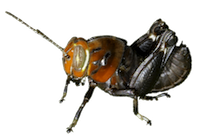
 »
»


